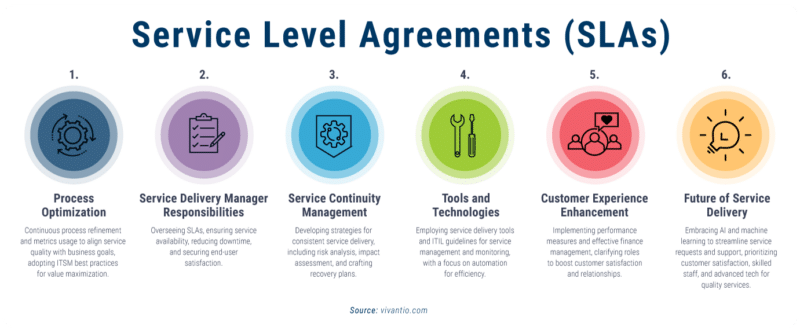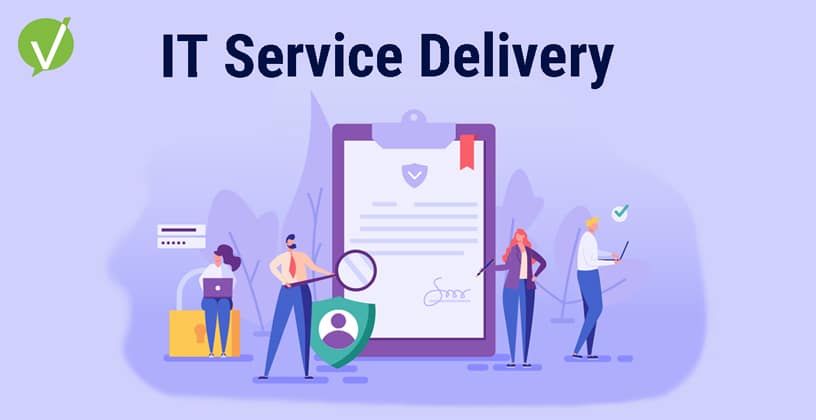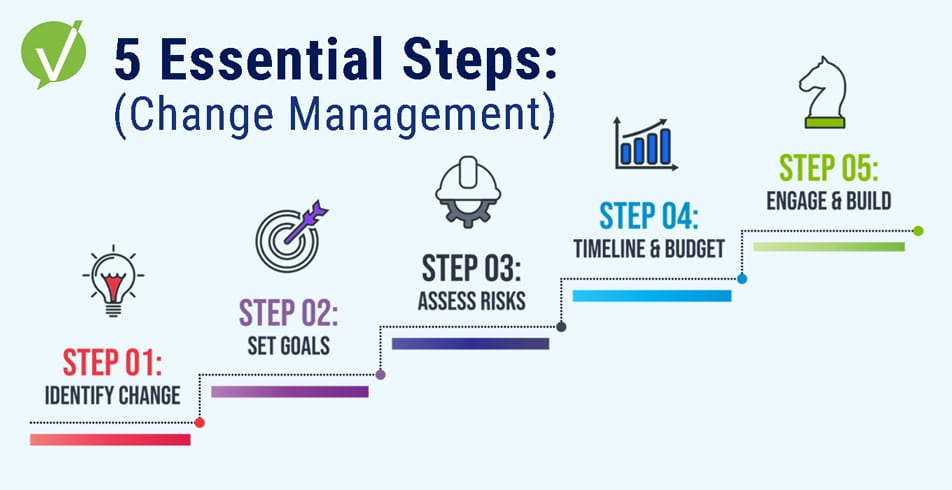IT Service Delivery: Enhancing Efficiency and Customer Satisfaction
Introduction
Businesses rely heavily on IT systems to drive efficiency and deliver exceptional customer experiences. That’s where IT service delivery comes into play. The IT service delivery framework encompasses a range of processes and practices that ensure the smooth and effective delivery of IT services to internal and external customers.
Why does this matter to businesses? This matters to businesses because an efficient IT service delivery framework directly impacts your operational performance, enabling you to meet customer expectations consistently, remain competitive in your industry, and achieve sustainable growth by leveraging technology effectively.
At the heart of successful IT service delivery is the service delivery manager. This key role is responsible for overseeing the customer service management process and ensuring that IT services align with business objectives. By implementing industry best practices such as ITIL (Information Technology Infrastructure Library), service delivery managers can optimize service delivery processes and drive continuous improvement.
The service delivery process involves several key components that work together to deliver efficient and effective IT services. These components include establishing a framework to guide service delivery activities, setting measurable Key Performance Indicators (KPIs) to track performance, creating a service catalog that outlines available services, establishing a service desk to handle customer requests and incidents, and defining clear Service Level Agreements (SLAs) to guarantee service quality and availability.
Aspect |
Description |
|---|---|
| Process Optimization | Organizations must continuously optimize processes and leverage metrics to ensure service quality aligns with business objectives, following ITSM best practices for maximum customer value. |
| Service Delivery Manager Responsibilities | Oversee SLAs, ensure service availability, minimize downtime, and guarantee end-user satisfaction. |
| Service Continuity Management | Implement strategies for uninterrupted service delivery through risk analysis, business impact assessment, and recovery plans development. |
| Tools and Technologies | Utilize service delivery tools and the ITIL framework for managing and monitoring IT services, with automation enhancing operational efficiency. |
| Customer Experience Enhancement | Focus on deploying service performance measures, managing finances effectively, and clarifying stakeholder roles to strengthen customer satisfaction and foster lasting relationships. |
| Future of Service Delivery | Leverage emerging technologies like AI and machine learning to improve efficiency in service requests and support, emphasizing the importance of customer satisfaction, skilled personnel, robust processes, and advanced technologies for delivering high-quality IT services. |
As the world of IT continues to evolve, the future of service delivery holds exciting possibilities. By leveraging technologies such as artificial intelligence and machine learning, handling service requests and providing support will become even more efficient. To deliver high-quality IT services, organizations must focus on improving customer satisfaction and invest in the necessary components, including skilled personnel, robust processes, and cutting-edge technologies.
Key Components of IT Service Delivery
In order to ensure smooth service delivery, several key components must be in place. These components include a framework, customer health metrics or KPIs, service catalog, service desk, and service level agreements (SLAs). Let’s explore each of these components in detail:
Framework
A framework serves as a structured approach for delivering IT services. It provides a set of guidelines and best practices that help organizations streamline their service delivery processes. By following a framework, organizations can ensure consistency, efficiency, and quality in their service delivery.
Customer Health Metrics – KPIs
Key Performance Indicators (KPIs) are measurable metrics used to track the performance of IT service delivery, including customer health metrics that gauge the satisfaction and engagement levels of customers. These metrics provide valuable insights into the effectiveness, efficiency, and customer-centricity of service delivery processes. By setting KPIs and incorporating customer health metrics, organizations can identify areas for improvement, measure their progress towards delivering superior customer experiences, and align their service delivery with business goals.
ITSM Service Catalog
An ITSM service catalog is a centralized repository that defines and categorizes the services offered by an organization’s IT department. It provides detailed information about each service, including its description, cost, availability, and support options. A well-structured service catalog helps both IT teams and end-users understand the available services and make informed decisions.
Service Desk
The service desk is the single point of contact for users seeking IT support and assistance. It serves as the interface between the IT department and end-users, handling service requests, incident management, and problem resolution. An efficient service desk plays a crucial role in maintaining high customer satisfaction and ensuring timely resolution of IT issues.
Service Level Agreements (SLAs)
Service Level Agreements (SLAs) are formal agreements that define the expected level of service between the IT department and its customers. SLAs outline the scope of services, response times, resolution targets, and other performance indicators. By establishing SLAs, organizations can set clear expectations, measure service quality, and hold the IT department accountable for meeting agreed-upon service levels.

By having a robust framework, well-defined KPIs, a comprehensive service catalog, a responsive service desk, and clear SLAs in place, organizations can ensure effective and efficient IT service delivery, leading to improved customer satisfaction and organizational success.
Optimizing Service Delivery Processes
Optimizing service delivery processes is essential for businesses to ensure efficient operations and deliver high-quality services to their customers. By implementing best practices in IT service management (ITSM) and utilizing relevant metrics, organizations can enhance service quality and drive customer satisfaction. In this section, we will explore strategies and insights on how to optimize service delivery processes.
Measuring Service Quality Using Metrics
Metrics play a crucial role in evaluating and improving service quality. By tracking key performance indicators (KPIs) such as response time, resolution time, and customer satisfaction ratings, businesses can gain valuable insights into their service delivery performance. These metrics enable service delivery managers to identify bottlenecks, address areas for improvement, and ensure that service quality meets or exceeds customer expectations.
Implementing Best Practices in IT Service Management (ITSM)
Adopting best practices in ITSM is vital for optimizing service delivery processes. ITIL (Information Technology Infrastructure Library) is a widely recognized framework that provides a set of guidelines and best practices for IT service management. By following ITIL principles, organizations can establish standardized processes, improve service quality, and enhance overall operational efficiency.
Enhancing Service Delivery Through Effective ITSM Practices
In order to enhance service delivery, organizations should focus on implementing effective ITSM practices. This includes creating a service catalog that clearly defines the available services and their associated details, streamlining service request workflows through customer service automation, and ensuring seamless communication and collaboration between IT teams and end-users. By leveraging ITSM practices, businesses can optimize service delivery processes, reduce operational costs, and drive better customer experiences.
Service Delivery Management Responsibilities
As a service delivery manager, your role is crucial in ensuring efficient IT service delivery and meeting the needs of end-users. You oversee various aspects of service delivery and collaborate with different teams to achieve optimal results.
By deploying robust service performance measures, organizations can ensure consistent and high-quality service delivery. It is the responsibility of the service delivery manager to oversee and optimize the various aspects of service delivery.
Roles and Responsibilities of a Service Delivery Manager
The roles and responsibilities of a service delivery manager encompass various aspects of service operations. Some of these include:
- Developing and implementing service delivery strategies
- Establishing and maintaining service level agreements (SLAs)
- Monitoring and evaluating service performance
- Managing customer relationships and ensuring customer satisfaction
- Collaborating with cross-functional teams to ensure effective service delivery
- Identifying and addressing service delivery gaps and bottlenecks
By effectively managing these responsibilities, service delivery managers can enhance the overall customer experience and help drive customer satisfaction. Service Continuity Management supports the manager’s efforts by ensuring that, even in the event of unexpected disruptions, services remain available and reliable, thereby maintaining customer trust and minimizing any potential negative impact on the customer experience.
Service continuity management comprises several key components that work together to ensure uninterrupted service delivery:
- Risk Assessment: Conducting a thorough risk assessment helps identify potential threats and vulnerabilities that may impact service delivery. This includes analyzing internal and external factors, assessing the likelihood and impact of each risk, and prioritizing mitigation efforts based on their severity.
- Business Impact Analysis (BIA): The BIA helps determine the criticality of different services and their dependencies on supporting systems. By conducting a BIA, organizations can assess the potential impact of disruptions and establish recovery objectives for each service.
- Continuity Planning: Developing continuity plans involves defining strategies and procedures to mitigate the impact of disruptions. This includes establishing backup systems, implementing redundancy measures, and devising incident response plans that ensure swift recovery and minimal disruption to service delivery.
- Testing and Exercising: Regular testing and exercising of continuity plans are essential to validate their effectiveness. This involves conducting scenario-based simulations, tabletop exercises, and live drills to identify gaps and fine-tune the plans accordingly.
- Maintenance and Review: Continuity plans should be regularly reviewed, updated, and tested to ensure their relevance and effectiveness over time. This includes conducting periodic risk assessments, revisiting recovery objectives, and incorporating lessons learned from real incidents into the plans.
By integrating these key components, organizations can establish a robust service continuity management framework that proactively addresses potential disruptions and ensures uninterrupted service delivery to their customers.
Benefits of Service Continuity Management |
|---|
| Minimizes downtime and business disruptions |
| Enhances customer satisfaction and confidence |
| Reduces financial losses associated with service interruptions |
| Helps meet regulatory and compliance requirements |
| Improves overall organizational resilience |
Catering to the Needs of End-Users
End-user satisfaction is a key priority in service delivery management. Understanding the needs and expectations of end-users allows you to tailor services to their requirements. By actively engaging with end-users and collecting feedback, you can identify areas where improvements can be made.
“Listening to the end-users and ensuring their needs are met is vital for delivering exceptional service.”
– John Smith, IT Service Manager
You also play a crucial role in advocating for end-users within the organization. By collaborating with stakeholders and decision-makers, you ensure that the end-users’ perspective is considered in service delivery decisions and improvements.
As a service delivery manager, your responsibilities encompass SLA management, overseeing service delivery activities, and catering to the needs of end-users. By effectively fulfilling these responsibilities, you contribute to the seamless delivery of IT services and the overall satisfaction of end-users.
Tools and Technologies for Effective Service Delivery
In today’s fast-paced digital landscape, the delivery of IT services is crucial for organizations to stay competitive and meet customer expectations. To ensure efficient and seamless service delivery, businesses rely on a variety of tools and technologies. In this section, we will explore some of the key tools and technologies that aid in the delivery of IT services, optimize service operations, and enhance overall customer satisfaction.
Service Delivery Tools
Service delivery tools are essential for managing and automating various aspects of the service delivery process. These tools empower organizations to streamline their service delivery operations, track performance, and ensure timely resolution of customer issues. Popular service delivery tools include:
- Service management platforms: Comprehensive platforms that enable end-to-end visibility and control over IT service delivery processes.
- Ticketing systems: Tools that help manage and track customer requests, incidents, and problems, ensuring prompt resolutions.
- Monitoring and alerting solutions: Tools that monitor the performance of IT infrastructure and applications, detecting and alerting IT teams about any issues or anomalies.
- Knowledge management systems: Platforms that centralize and organize knowledge resources, empowering IT service teams to provide accurate and consistent support.
Automation: Streamlining Service Operations
Automation plays a crucial role in streamlining service operations and improving the efficiency of IT service delivery. By automating manual and repetitive tasks, organizations can reduce human error, accelerate response times, and free up resources for more strategic initiatives. Key areas where automation can greatly benefit IT service delivery include:
- Incident and problem management: Automating incident categorization, prioritization, and routing, ensuring faster resolutions and minimizing disruption to end-users.
- Change management: Automating change approvals and workflows, reducing the risk of failed changes and ensuring smooth transitions.
- Request fulfillment: Automating the fulfillment of service requests, enabling self-service options for end-users and reducing dependency on manual interventions.
- Configuration management: Automating the discovery, tracking, and management of IT assets, ensuring accurate and up-to-date configuration data.
By leveraging the power of automation, organizations can streamline their service delivery processes, improve operational efficiency, and deliver exceptional customer experiences.
The Future of IT Service Delivery
The future of IT service delivery is poised to revolutionize the way organizations provide support to their customers. As businesses continue to rely heavily on technology, the demand for efficient and effective service delivery is on the rise. To meet these expectations, several key trends are shaping the future of IT service delivery.
One notable trend is the shift towards self-service options for service requests. With an increasing emphasis on user empowerment and convenience, organizations are implementing intuitive online portals and mobile applications that allow customers to submit service requests and track their progress in real-time. This not only streamlines the request process but also improves customer satisfaction by providing a quicker and more accessible means of support.
For over twenty years, Vivantio has been at the forefront of enhancing IT service delivery for clients looking to excel in a rapidly evolving business landscape. By focusing on IT service delivery, your organization can effectively navigate through challenges and seize new opportunities with agility and precision. Discover how Vivantio can elevate your IT service delivery processes and outcomes. Contact our expert team today or sign up for a free demo to see the difference firsthand.













